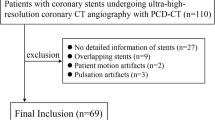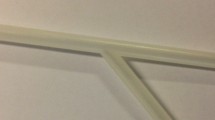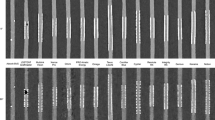Abstract
The purpose of this study was to evaluate improvement of measurement accuracy of in-stent lumen using coronary stent phantoms on new High-Definition CT (HDCT) compared with conventional 64 detector-row CT (MDCT). To estimate the spatial resolution, a high-resolution insert of CATPHAN (The Phantom Laboratory, NY, USA) was scanned by both HDCT (Discovery CT750 HD) and MDCT (LightSpeed VCT). Also, we developed six types of stent phantom, which have 2.5- and 3.0-mm-diameter with three different types of stents (Velocity: Johnson & Johnson, Driver: Medtronic, Multilink-Rx: Guidant). A 50% stenotic segment made of acrylic resin was built at the center inside the stent. Those coronary vessel phantoms were made of acrylic resin and filled with diluted Iodine (350 HU in 120 kVp), and each stent was fixed inside of those vessels. Those phantoms in water-filled tank were scanned on both HDCT and MDCT. The luminal diameter obtained using digital calipers at five different points and the mean luminal diameter (MLD) were calculated. The underestimate ratio (UR) and △UR was defined as follows: UR = [True diameter of stent—MLD]/True diameter of stent; △UR = [MLD at HDCT—MLD at MDCT]/True diameter of stent. The spatial resolution was estimated to be 0.71 mm on MDCT and 0.50 mm on HDCT. At the non-stenotic segments, the △URs were 11.6% (Velocity), 16.4% (Driver) and 7.2% (Multilink) for the 2.5-mm stents, and 14.0% (Velocity), 16.3% (Driver) and 13.3% (Multilink) for the 3.0-mm stents. At the stenotic segment, the △URs were 23.2% (Velocity), 8.0% (Driver) and 13.6% (Multilink) for the 2.5-mm stents, and 20.0% (Velocity), 14.7% (Driver) and 15.3% (Multilink) for the 3.0-mm stents. Superior spatial resolution of HDCT could be promising for more accurate measurement of in-stent diameter.




Similar content being viewed by others
References
Morice MC, Colombo A, Meier B et al (2006) Sirolimus- vs paclitaxel-eluting stents in de novo coronary artery lesions: the REALITY trial: a randomized controlled trial. Jama 295:895–904
Holmes DR Jr., Leon MB, Moses JW et al (2004) Analysis of 1-year clinical outcomes in the SIRIUS trial: a randomized trial of a sirolimus-eluting stent versus a standard stent in patients at high risk for coronary restenosis. Circulation 109:634–640
Flohr TG, McCollough CH, Bruder H et al (2006) First performance evaluation of a dual-source CT (DSCT) system. Eur Radiol 16:256–268
Rybicki FJ, Otero HJ, Steigner ML et al (2008) Initial evaluation of coronary images from 320-detector row computed tomography. Int J Cardiovasc Imaging 24:535–546
Schroeder S, Achenbach S, Bengel F et al (2008) Cardiac computed tomography: indications, applications, limitations, and training requirements: report of a Writing Group deployed by the Working Group Nuclear Cardiology and Cardiac CT of the European Society of Cardiology and the European Council of Nuclear Cardiology. Eur Heart J 29:531–556
Rixe J, Achenbach S, Ropers D et al (2006) Assessment of coronary artery stent restenosis by 64-slice multi-detector computed tomography. Eur Heart J 27:2567–2572
Kumbhani DJ, Ingelmo CP, Schoenhagen P et al (2009) Meta-analysis of diagnostic efficacy of 64-slice computed tomography in the evaluation of coronary in-stent restenosis. Am J Cardiol 103:1675–1681
Taylor AJ, Cerqueira M, Hodgson JM et al (2010) ACCF/SCCT/ACR/AHA/ASE/ASNC/SCAI/SCMR 2010 Appropriate Use Criteria for Cardiac Computed Tomography. A Report of the American College of Cardiology Foundation Appropriate Use Criteria Task Force, the Society of Cardiovascular Computed Tomography, the American College of Radiology, the American Heart Association, the American Society of Echocardiography, the American Society of Nuclear Cardiology, the Society for Cardiovascular Angiography and Interventions, and the Society for Cardiovascular Magnetic Resonance. CARDIAC COMPUTED TOMOGRAPHY WRITING GROUP, Journal of the American College of Cardiology. J Am Coll Cardiol 56:1864–1894
Mahnken AH, Seyfarth T, Flohr T et al (2005) Flat-panel detector computed tomography for the assessment of coronary artery stents: phantom study in comparison with 16-slice spiral computed tomography. Invest Radiol 40:8–13
Vartuli JS, Lyons RJ, Vess CJ et al (2008) GE Healthcare’s New Computed Tomography Scintillator—Gemstone. Symposium on Radiation Measurement and Applications, June 2–5, Berkeley, California
Min JK, Swaminathan RV, Vass M et al (2009) High-definition multidetector computed tomography for evaluation of coronary artery stents: comparison to standard-definition 64-detector row computed tomography. J Cardiovasc Comput Tomogr 3:246–251
Sheth T, Dodd JD, Hoffmann U et al (2007) Coronary stent assessability by 64 slice multi-detector computed tomography. Catheter Cardiovasc Interv 69:933–938
Author information
Authors and Affiliations
Corresponding author
Rights and permissions
About this article
Cite this article
Tanami, Y., Jinzaki, M., Yamada, M. et al. Improvement of in-stent lumen measurement accuracy with new High-Definition CT in a phantom model: comparison with conventional 64-detector row CT. Int J Cardiovasc Imaging 28, 337–342 (2012). https://doi.org/10.1007/s10554-010-9786-x
Received:
Accepted:
Published:
Issue Date:
DOI: https://doi.org/10.1007/s10554-010-9786-x




